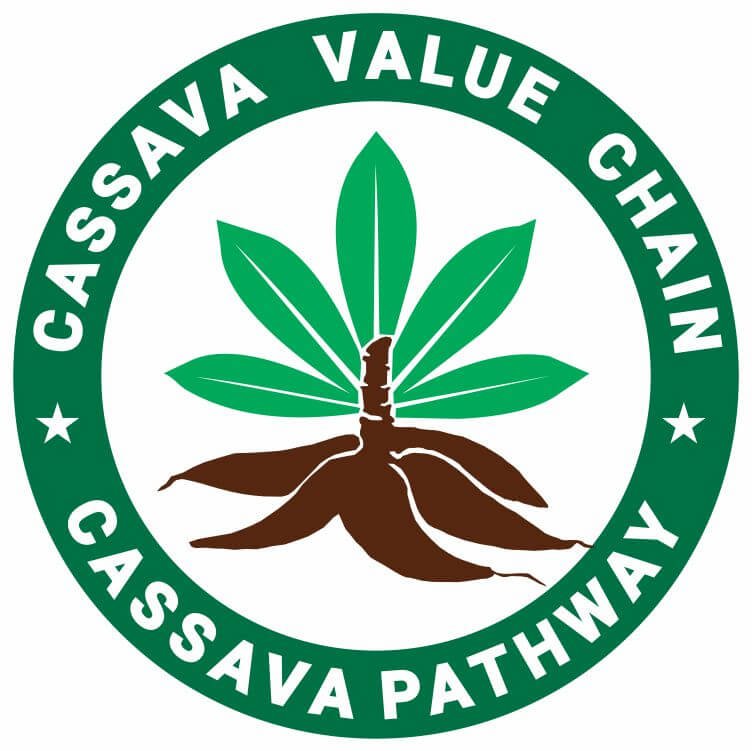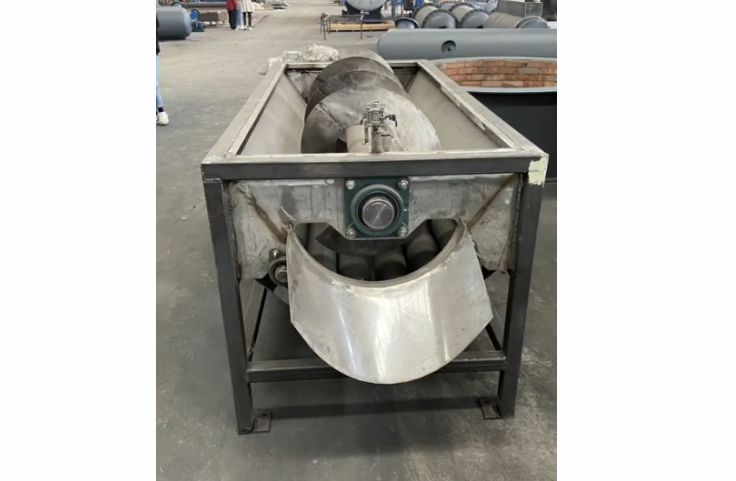Cassava peeling machine transforms how cassava is processed, but what makes it a must-have for modern farms and factories? See how it changes the game in minutes.
The cassava peeling machine gives you a faster and easier way to process cassava without the heavy labor.
If you are a cassava farmer or work with it, you already know how time-consuming and tiring manual peeling can be.
The thick skin takes effort to remove, and doing it by hand slows everything down.
That’s where this machine changes the game. It quickly peels large batches of cassava roots while keeping the flesh intact, so you waste less and produce more.
Whether you’re running a small operation or a larger processing setup, the machine can fit into your workflow and help you keep up with demand.
It cuts labor costs, saves time, and keeps your production line moving.
If you want to turn raw cassava into flour, starch, or snacks faster and with less hassle, this tool gives you a practical and smart way forward. More on how to peel cassava roots.
Table of Contents
- Understanding the Cassava Peeling Machine
- How a Cassava Peeling Machine Works
- Benefits of Using a Cassava Peeling Machine
- Types of Cassava Peeling Machines
- Features to Consider Before Buying
- Cassava Peeling Machine Price Range
- Applications in the Cassava Processing Chain
- Maintenance and Safety Tips
- Where to Buy Reliable Cassava Peeling Machines
- Frequently Asked Questions
- Conclusion
Understanding the Cassava Peeling Machine
Cassava peeling machine helps you save time and labor by removing the thick skin from cassava roots with precision.
It’s a smart way to improve your cassava processing setup.
What a Cassava Peeling Machine Does for You
You no longer have to spend hours peeling cassava by hand. A cassava peeling machine takes care of that for you.
It removes the tough skin quickly and evenly, making your work easier and faster.
This tool is designed to clean off the outer layer without damaging the edible part of the root.
That means less waste and more usable cassava to turn into flour, starch, or food products.
Related: How the Cassava Chipper Machine Works
Why Manual Peeling Slows You Down
Manual peeling takes effort, especially when you’re dealing with large quantities.
It’s hard to keep up with orders or daily production when every root has to be peeled by hand.
You also risk leaving parts of the skin behind, which can affect product quality.
A peeling machine solves these problems. It works fast, gives cleaner results, and keeps your output consistent throughout the day.
The Right Machine for the Work You Do
Choosing the right cassava peeling machine depends on how much you process.
If you run a small shop or farm, a manual-assisted machine might be enough.
It’s simple to operate and doesn’t require much power.
For growing businesses, a semi-automatic machine gives you more speed with less physical effort.
If you run a large factory, a fully automatic machine is better. It handles large batches with almost no need for manual help.
Related: Top Manufacturers of Cassava Processing Machines
Fitting the Machine into Your Operation
You don’t need to change your whole system. These machines are made to work with what you already have.
They connect well with washers, chippers, or any other machines you use in cassava processing.
You can set up a smooth line where roots go from peeling straight into the next step.
That saves time and keeps your production moving without interruptions.
Related: How the Cassava Grater Machine Works
How a Cassava Peeling Machine Works
Cassava peeling machines save time and labor by speeding up the peeling process with clean results.
Here’s a look at how each part of the machine works step by step.
Feeding the Cassava into the Machine
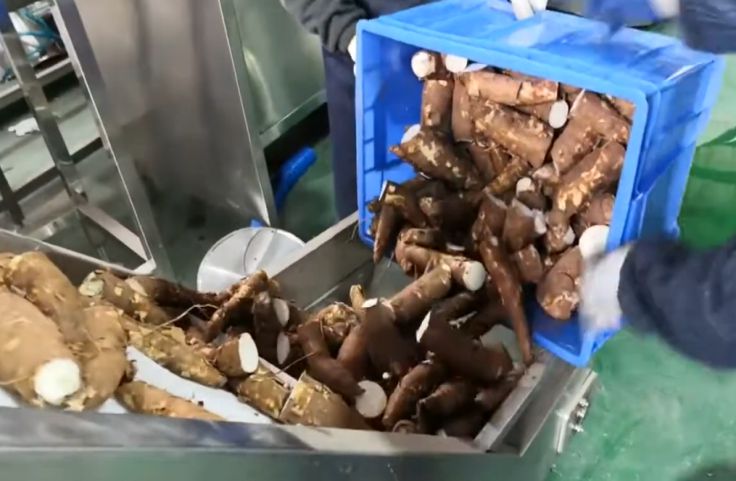
You start by placing whole, unpeeled cassava into the drum. The opening is wide enough to hold large tubers.
Once the cassava is inside, the machine gets to work. No need for manual scraping or cutting.
This step prepares the tubers for automatic peeling and ensures they stay in place as the drum begins to rotate.
The more evenly you feed the cassava, the better the peeling result.
Drum Rotation and Blade Contact
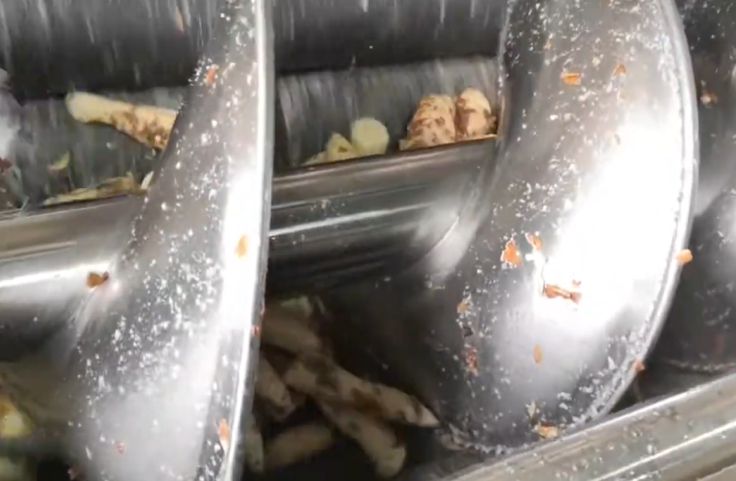
The moment you power the machine, the drum starts spinning.
As it turns, the cassava rubs against the sharp internal blades.
These blades are set to the right depth to peel off just the skin without wasting the flesh.
This movement is where most of the peeling happens. You don’t need to stop or shift the tubers manually.
Everything moves inside smoothly on its own.
Adjustable Blade and Speed Settings
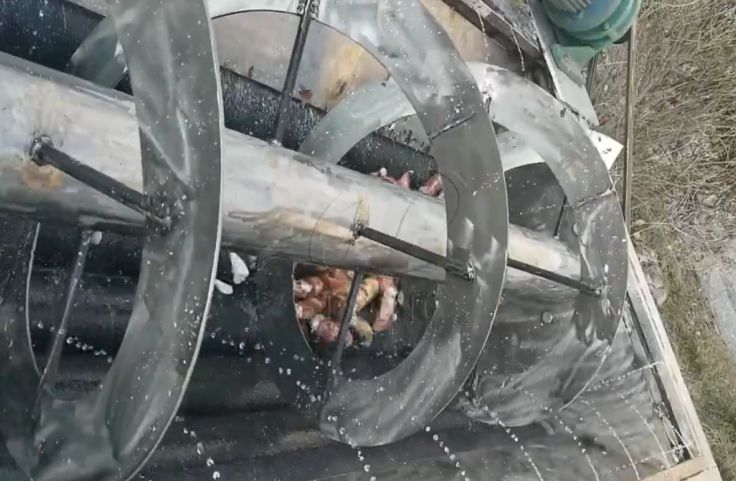
Different cassava varieties have different skin thicknesses.
That’s why you can adjust both the blade pressure and rotation speed.
If you’re working with softer or smaller tubers, slow it down. For harder or thicker ones, turn it up a bit.
This flexibility helps you get clean results without damaging the cassava.
You stay in control of how fast and how deep the peeling goes.
Separation and Collection
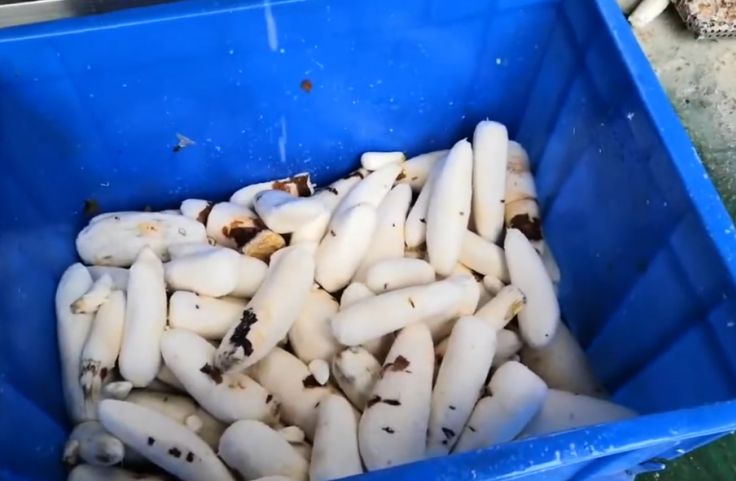
Once peeled, the cassava and skin parts move toward the exit. A built-in system separates the good tubers from the waste.
Skins drop into one container while peeled cassava moves to another.
This keeps your work area clean and saves time you’d otherwise spend sorting.
The peeled tubers come out ready for further processing, grating, drying, or cooking.
Related Posts
Cassava Processing Equipment Guide
Multi-Function Cassava Processing Units
5 Must-Have Cassava Processing Machines for Small Businesses
Guide to Cassava Ethanol Production
Grated Cassava: Uses, Recipe, and How it is Made
Modern Methods of Processing Cassava
Traditional Methods of Processing Cassava
Cassava Grinding Machine Guide
Benefits of Using a Cassava Peeling Machine
Using a cassava peeling machine helps you save time, cut costs, and improve product quality.
Here’s how it can make your cassava processing faster, cleaner, and more efficient.
Increase in Output and Faster Processing
Cassava peeling machines let you process more in less time.
They keep a steady pace, reduce downtime, and help you meet growing demands, whether you’re running a small operation or a large processing plant.
Lower Labor Costs and Less Physical Strain
With fewer hands needed for peeling, you cut labor costs and reduce worker fatigue.
Your team can focus on other tasks while avoiding the physical strain that comes with manual cassava peeling.
Precise Peeling with Less Waste
The machine peels accurately without cutting too deep, giving you a higher yield from each tuber.
This reduces waste, saves money, and ensures more cassava is ready for use or sale.
Cleaner Work Process and Better Hygiene
Machines create a neater, safer workspace. Less human contact means less risk of contamination, and easier cleanup keeps your processing area in line with food safety standards and customer expectations.
Related: Cassava Flash Dryer: Everything to Know
Types of Cassava Peeling Machines
Cassava peeling machines help you speed up cassava preparation while cutting down on waste and manual labor.
Here are the main types and how they work in different setups.
Drum Type Cassava Peeling Machine
This type of cassava peeler works best when you’re handling large quantities and need a fast turnaround.
The machine uses a rotating drum with rough inner surfaces that scrape the skin off as the tubers tumble inside.
You just load the cassava, switch on the machine, and let it spin. The skin comes off cleanly without much input.
You can adjust the settings to match different sizes or skin thickness.
Drum-type peelers are ideal for farms or factories aiming to process more in less time while reducing the stress of manual labor.
Brush Type Cassava Peeling Machine
If your goal is gentle peeling with less waste, this machine is a good fit.
It uses durable brushes to scrub off cassava skin while keeping the flesh intact.
This is helpful when you want to maintain the full body of each tuber for further use.
It’s great for small-scale processors or setups with limited space.
The brushes clean effectively without causing damage, making it a preferred choice when cassava quality matters.
You don’t need many people to operate it, and it works quietly, making your work easier and your space less chaotic.
Abrasive Belt Cassava Peeling Machine
When speed is your top priority, this machine delivers. It uses a fast-moving belt coated with a rough surface that strips the skin from the cassava as it moves along.
You feed the tubers in, and the belt does the work nonstop.
This setup is perfect for large operations that deal with constant flow and high volume.
It reduces delays and handles multiple tasks at once, helping you meet tight deadlines.
If you’re working in a factory or a high-output processing center, this machine helps you stay ahead without compromising output consistency.
Related: Guide to Buying a Cassava Dewatering Machine
Hybrid or Custom Cassava Peeling Machine
If standard machines don’t meet your needs, hybrid or custom options might work better.
These machines blend features from different types, like drums, brushes, or belts, to create a system that fits your setup.
You can use them to process unusual cassava sizes or meet specific production goals.
They’re often built to match custom factory layouts, giving you more control over output.
Though they require more planning and investment, they pay off by boosting productivity and reducing processing problems.
If your operation has special requirements, a custom machine can match your exact needs.
Related: Importance of the cassava sieving machine in cassava processing
Features to Consider Before Buying
Before choosing a cassava peeling machine, you need to focus on features that affect output, maintenance, and overall fit for your setup.
Here’s what to look out for before you invest.
Peeling Capacity per Hour
Think about how much cassava you need to process daily. Machines with higher peeling capacity help you save time and keep up with demand.
If you run a large facility, choose a machine that matches your volume.
For smaller setups, a lower-capacity machine may be more practical and cost-effective.
Power Source and Energy Needs
Check what power sources are available where you operate.
Cassava peeling machines may run on electricity, diesel, or manual power. If you’re in a remote location, diesel may work better.
For clean and quiet operations, electric machines are a better fit. Match the machine to your site’s energy setup.
Material Strength and Build Quality
The material used in the machine affects how long it will last and how much care it needs.
Stainless steel is strong, rust-resistant, and easy to clean. Carbon steel can be cheaper, but it needs more maintenance.
Choose based on your budget, climate, and hygiene needs in cassava processing.
Cleaning and Maintenance
You’ll want a machine that’s easy to take apart and clean.
Look for removable parts or open designs that let you reach inside quickly.
This keeps your processing area clean, reduces the risk of contamination, and cuts down on machine downtime between peeling cycles or production shifts.
Level of Automation and Safety
Automation can speed up your work and reduce errors, but it usually comes with a higher price.
Think about your team’s skill level and daily targets. Also, don’t ignore safety.
Look for machines with guards, emergency shut-off features, and clear instructions to protect everyone handling the equipment.
Cassava Peeling Machine Price Range
Cassava peeling machine prices vary widely based on machine size, features, and origin.
Knowing what affects the cost helps you make better choices that suit your budget and processing needs.
Small Manual Machines for Basic Use
If you’re running a small farm or peeling cassava on a limited scale, manual or semi-automatic machines may be all you need.
These typically range from $300 to $1,000. They cost less because they’re built for light use and don’t come with high-end features.
You get basic peeling capacity and fewer moving parts, making them easier to operate and maintain without skilled labor.
Medium to Large Machines for Commercial Processing
Commercial operations need faster processing speeds and higher capacity.
These machines can range from $2,000 to $10,000, depending on size and output.
The bigger the machine and the more cassava it can handle per hour, the higher the cost.
These machines often include stronger motors, better peeling precision, and continuous processing systems designed for long shifts.
Features That Affect Price
Price is not just about size. Features like automation level, energy efficiency, and peeling speed also push up the cost.
Machines with sensors, touch controls, or self-cleaning parts can cost more but save you time and effort later.
While cheaper machines may look appealing, the right features can pay off in daily use and long-term savings.
Country of Origin and Brand Influence
Machines made locally are usually more affordable than imported ones, especially when you factor in shipping, taxes, and spare part availability.
Well-known brands may cost more but come with better support, warranties, and trusted performance.
Before buying, compare prices against the support, reliability, and availability of parts in your region.
Value Over Time and Long-Term ROI
You don’t just buy a cassava peeling machine for today. You’re investing in speed, lower labor costs, and less wastage.
A reliable machine can pay for itself in a short time.
Take time to weigh the upfront cost against how much time and labor it will save you each month.
A smarter purchase now brings bigger returns later.
Applications in the Cassava Processing Chain
Cassava peeling machines help you speed up production and improve the quality of your end products.
Here’s how they fit into different stages of cassava processing and why they matter.
Prepping Tubers for Washing and Chipping
Once the cassava is peeled, it’s easier to wash and prepare for chipping or grinding.
The machine strips off the rough outer skin, leaving the clean inner part ready for the next stage.
This helps reduce dirt, speeds up cleaning, and makes sure the chipped cassava is free from impurities.
It’s the first real step in getting consistent quality in cassava flour or chips.
Boosting Output in Cassava Flour Production
Manual peeling slows down flour production and affects yield.
With a peeling machine, you can feed more tubers into the system and maintain a steady flow.
The more consistent the peeling, the smoother the grinding and sieving processes become.
If you’re running a small flour mill or planning to grow, this is one area where automation makes a big difference.
Cleaner Results for Garri and Cassava Chips
Garri and cassava chips need clean, evenly peeled tubers.
If the peeling is rough or uneven, it shows in the final product.
A good machine helps you avoid this. You get a cleaner base, which means fewer impurities and better taste.
For local sellers and cooperatives, this translates to better quality control and fewer returns or complaints.
Smoother Integration with Other Machines
Peeling machines work well with washers, chippers, and grinders. Once set up, the workflow becomes seamless.
You can move peeled cassava straight to the next machine without stopping to sort or re-clean.
That saves time and labor. You get a setup that flows, reducing downtime and helping you process more cassava every day.
Better Supply Chain and Product Consistency
By peeling faster and more consistently, you reduce delays between harvest and finished goods.
Whether you’re making starch, flour, or snacks, faster peeling helps shorten the time from farm to shelf.
This helps you meet orders on time and deliver cassava products that meet market standards without cutting corners.
Maintenance and Safety Tips
Taking care of your cassava peeling machine keeps it running smoothly and safely.
Here’s what you should focus on after each use and during regular operation.
Clean the Machine After Every Use
Once you’re done peeling for the day, don’t leave the machine dirty. Cassava residue can harden and clog parts if ignored.
Use a soft brush or cloth to remove leftovers and wipe down all surfaces. Pay attention to hard-to-reach areas and moving parts.
This keeps the machine clean, reduces the chance of corrosion, and helps maintain food safety in your work area.
Keep the Blades Sharp and Ready
Dull blades slow down peeling and make your results uneven.
That means more waste and longer processing time.
Take a few minutes each week to check for nicks, dull edges, or worn-out parts.
Sharpen the blades with a proper tool or replace them when needed.
This small step improves output and helps avoid strain on the motor from jammed or slow peeling.
Set a Maintenance Routine
A simple checklist can help you stay ahead of problems.
Set dates to inspect the motor, check the belts, test the safety stop, and clean every moving part.
If you notice anything unusual, odd sounds, slow movement, or overheating, deal with it early.
Tracking maintenance helps spot recurring issues and saves you from costly downtime during peak processing times.
Practice Safe Handling and Operation
Make sure everyone using the machine knows how to operate it safely. Keep hands and tools away from moving parts.
Show workers how to switch off the power quickly in case of an emergency.
Gloves, goggles, and ear protection should be used every time.
These steps protect the people working with the machine and reduce injury risks.
Store in a Dry and Secure Area
When the machine is not in use, store it in a dry space away from moisture and dust.
Moisture can rust metal parts, especially if you’re using a model made with carbon steel.
Cover it properly, disconnect the power source, and keep tools or spare parts nearby.
Good storage habits help extend the machine’s lifespan.
Where to Buy Reliable Cassava Peeling Machines
Finding a cassava peeling machine that works well and lasts long depends on where you buy it.
Here’s how to choose a trusted source and what to check before making a purchase.
Check Local Agro-Machinery Markets and Dealers
Start by visiting local markets that specialize in farming tools and machines.
These places let you inspect the cassava peeling machine in person.
You can ask questions, see how it runs, and hear from people who’ve already used it. Some suppliers even offer quick demos.
Buying locally also makes it easier to follow up if you need repairs, support, or spare parts later.
Compare Manufacturers from China, Nigeria, and India
Countries like China, Nigeria, and India produce a wide range of cassava processing machines.
Chinese manufacturers offer advanced models at lower prices, while Nigerian and Indian brands focus more on local farming needs.
Companies like Henan Yuhong in China, Kiran Agro in India, and verified sellers on Jiji.ng in Nigeria are good starting points.
Look for brands with solid reviews and working experience with cassava equipment.
Ask About Warranty and Spare Parts Before You Pay
Before you finalize the deal, make sure the seller offers a clear warranty. This protects you if the machine breaks down too soon.
Also, ask about spare part availability. Can you get a new blade, motor, or belt without waiting weeks?
A good machine should come with after-sales support and parts that are easy to find and replace when needed.
Talk to Other Users or Join Farming Forums
Word of mouth matters. Reach out to cassava processors or small factory owners and ask what machines they use.
Their feedback can help you avoid bad buys and guide you toward trusted dealers.
You can also join online forums or local farming groups where people share real stories about where they bought their machines and how well they’re holding up.
Frequently Asked Questions
How much does a cassava peeling machine cost?
Cassava peeling machines range from $300 for manual types to over $10,000 for fully automatic models with high capacity and advanced features.
What is the capacity of a cassava peeling machine?
Capacity varies by model. Small units handle 200 to 500 kg per hour, while industrial machines process up to 2,000 kg or more hourly.
Can cassava peeling machines damage the tuber?
No, modern machines use adjustable blades or brushes to peel without cutting deep, keeping the edible cassava flesh safe and usable.
Is a cassava peeling machine suitable for small farms?
Yes, smaller models are designed for farms with limited output. They’re affordable, simple to maintain, and improve speed without needing much training.
Conclusion
A cassava peeling machine saves you time, lowers costs, and improves product quality across every stage of processing.
From reducing manual labor to increasing your daily output, this machine helps you work smarter and deliver better results.
Whether you’re making flour, garri, chips, or starch, fast and clean peeling keeps your production line efficient.
It also helps you meet safety standards with less hassle.
With so many types, sizes, and price options available, you can find a machine that fits your setup and goals.
Invest wisely, maintain it well, and watch your cassava processing move faster with less stress and more profit.
References

Chimeremeze Emeh is a writer and researcher passionate about Africa’s most transformative root crop—cassava. Through his work at cassavavaluechain.com, he explores the entire cassava industry, from cultivation and processing to its diverse applications in food, health, and industrial use.
He also writes for palmoilpalm.com, where he shares his extensive experience and deep-rooted knowledge of palm oil, covering red palm oil, palm kernel oil, and refined products. His work there reflects his lifelong connection to agriculture and his commitment to promoting sustainable value chains in Africa.
Driven by curiosity and purpose, Chimeremeze aims to shed light on how cassava continues to empower communities, strengthen food systems, and link traditional farming wisdom with modern innovation.
